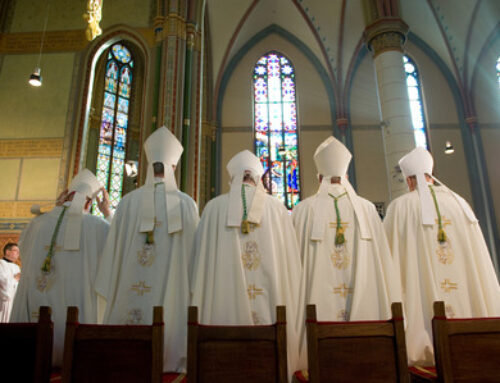 Part I: Having affected the lives of half the members of the human race in innumerable ways for millennia, the denigration of women is clearly the greatest single injustice in human history and continues to be a stain on culture and religion alike. Part II: The Church can correct its role in this denigration by identifying elements of unloving conduct toward women that exist in its teachings and replacing them with thoughts and behavior more in keeping with Christ’s commandment to love one’s neighbor.
Part I: Having affected the lives of half the members of the human race in innumerable ways for millennia, the denigration of women is clearly the greatest single injustice in human history and continues to be a stain on culture and religion alike. Part II: The Church can correct its role in this denigration by identifying elements of unloving conduct toward women that exist in its teachings and replacing them with thoughts and behavior more in keeping with Christ’s commandment to love one’s neighbor.
Before addressing the challenge to the Church set forth in Part II, it is important to understand the context of that challenge. I will begin by addressing an argument commonly advanced about the Church’s role in the denigration of women. That argument is: Whatever denigration of women the Church may have shown is more than compensated by the positive view of women it has advanced.
The most obvious supporting evidence for this argument is the historic view of Jesus’ mother Mary. The Church designated her as “Blessed Virgin Mary” and “Queen of Heaven.” Moreover, by declaring her to have been conceived “immaculately”—that is, free from the stain of Original Sin—the Church has elevated her above other human beings in a singular way. English poet William Wordsworth had this in mind when he lauded Mary as “our tainted nature’s solitary boast.”
The Church has also declared hundreds of women to be saints and held them up to veneration as models of virtue. Some of those women, notably St. Teresa of Avila and St. Catherine of Siena, have also been named “Doctors of the Church” in recognition of their theological insights.
Such evidence of the Church’s positive view of women is considerable and indisputable, but then so is the evidence of the negative view of women advanced by the Church! How can this apparent contradiction be explained? The answer, I believe, is that the Church has been much more inclined to honor women who repressed their sexuality than those who expressed it in marriage. (There are exceptions to this pattern of honoring, but they are comparatively few.)
The underlying message in the Church over the centuries has been that there is something morally questionable, if not downright evil, about women’s sexuality, and therefore, generally speaking, women can achieve holiness only by repressing it.
Some would challenge this assertion, noting that the Church has always taught that there is something wrong with BOTH men and women—that is, that both bear the stain of Original Sin, and therefore both are sinners. That has, indeed, been the Church’s teaching. But the Church Fathers also taught that women are more responsible than men for sin:
As noted in Part I, Tertullian said to women, ““God’s sentence hangs still over all your sex and His punishment weighs down upon you. You are the devil’s gateway . . . Woman, you are the gate to hell.” St. Clement of Alexandria taught, “[Women’s] very consciousness of their own nature must evoke feelings of shame.” And St. Thomas Aquinas believed, “As regards the individual nature, woman is defective and misbegotten . . . .”
Moreover, St. Jerome went so far as to suggest that women are more responsible for men’s sexual sins than men are because though men are tempted, women do the tempting. Writing to a young girl, Jerome ascribed lustful motives to her: “The way you dress is an index of your secret desires. Your bodice is purposely ripped apart to show what is beneath, and, while hiding what is repulsive, to reveal what is beautiful. You wear stays to keep your breasts in place, and confine your body in a girdle. Sometimes you let your shawl drop so as to lay bare your white shoulders . . .” (If this passage seems vaguely familiar to modern readers, it is because some people still say that a woman who dresses immodestly is “asking” to be assaulted.)
The impact of these messages on Western society in particular and the world in general has been profound and lasting. For most of the last 2000 years the masses were uneducated and often illiterate. Books were few until Gutenberg invented the printing press in the mid-fifteenth century, and as late as 1700 most scholarly works were still in Latin. What the laity learned of God, the nature of men and women, and most other subjects came almost solely from priests. And priests’ instruction came not only from the Bible but also from the teachings of theologians like those mentioned above.
Thus the Church’s denigration of women helped to create the thinking patterns and attitudes toward women that contributed to the following situations, among others:
Under the Napoleonic Code of 1804, French women, as well as criminals and the insane, had the same legal status as minor children. Husbands controlled their wives’ property and, in the case of divorce, automatically got custody of the children. (The first U.S. state that allowed women to own property in the U.S. was Oregon, in 1850.)
In most countries women were denied the right to vote for centuries. In 1873, for example, in Bradwell v. Illinois, the U.S. Supreme Court held that that a state can exclude women from voting simply because of their gender. The majority legal opinion held that “[t]he paramount destiny and mission of woman are to fulfill the noble and benign offices of wife and mother. This is the law of the Creator.” Only in 1920 was the U.S. Constitution amended to guarantee women the right to vote, a half-century after black men were enfranchised. And most other countries took even longer to affirm that right—Britain in 1928, Japan in 1947, and Switzerland in 1971.
Even after it became socially acceptable for women to work outside the home, the notion persisted that women lack the mental and emotional capability to work in challenging fields. The first European university to admit women was the University of Zurich in 1865; the first coeducational college in America was Oberlin in 1833. Furthermore, even as late as the mid-20th century careers such as science, mathematics, medicine, and industry were largely closed to women. School counselors typically advised young women into apply to secretarial schools or nursing or teaching programs rather than more academically demanding curriculums.
To summarize, although the Catholic Church has led secular society in recognizing the dignity of women who have taken a vow of celibacy, it has been behind secular society in acknowledging the dignity of other women. The reason for the latter difficulty has been the continuing (albeit it unconscious) embrace of the Church Fathers’ negative view of women.
Clinging to the ancient view of woman in its various expressions has proven increasingly difficult in the modern era, particularly in the last several decades. In support of this assertion, I offer a single example from the widely praised and widely criticized encyclical of Pope Paul VI, Humanae Vitae (paragraph 21).
The right and lawful ordering of birth demands, first of all, that spouses fully recognize and value the true blessings of family life and that they acquire complete mastery over themselves and their emotions. For if with the aid of reason and of free will they are to control their natural drives, there can be no doubt at all of the need for self-denial. Only then will the expression of love, essential to married life, conform to right order. This is especially clear in the practice of periodic continence. Self-discipline of this kind is a shining witness to the chastity of husband and wife and, far from being a hindrance to their love of one another, transforms it by giving it a more truly human character. [Emphasis added.]
Pope Paul then proceeds to list the benefits of self-denial in marriage, which include making the couple more responsible, more thoughtful of each other, and more tranquil. This message has struck many Catholics as too theoretical and utopian, with little relevance to real marital relationships. Such readers are also puzzled that Pope Paul could frame the message as he did after receiving the report of the Papal Commission on Birth Control that offered a very different viewpoint.
From the perspective of married people who had served on the Papal Commission, Pope Paul seemed to be saying, in effect, “Here is a wonderful gift from God Himself, and the best way to show your appreciation for it is to refrain from using it.” Why would he allow his words to carry this implication? It is impossible to say for sure, but it is not unreasonable to believe that, consciously or unconsciously, he was conforming to the view St. Augustine expressed seventeen centuries ago: “What is the difference whether it is in a wife or a mother, it is still Eve the temptress that we must beware of in any woman… I fail to see what use woman can be to man, if one excludes the function of bearing children.”
Why have theologians and Pontiffs continued to reinforce a denigrating view of women fashioned almost two millennia ago, a view that is not only unjust but lacking in the love (agape) at the center of our religion?
One reason is their respect for the larger philosophical contributions of the men who framed that denigrating view, most of them declared saints. Another is their fear that changing the Church’s view of women would raise a host of vexing philosophical and theological issues. A third reason is their concern that the Church might lose credibility and endanger its role as a leading arbiter of morality.
Such concerns are not without merit. Respecting great saints, avoiding vexing issues, and maintaining the Church’s image are all legitimate ends. However, they neither singly nor collectively justify the means employed to reach them—perpetuating a slander against half of the human race.
I submit that the appropriate response—indeed, the moral imperative—for the Catholic hierarchy is to formally renounce the historic error in the Church’s view of women and, more importantly, to re-examine Church teachings on the two matters most powerfully influenced by that error—the priesthood and marriage. In a subsequent essay I will explain how this re-examination can be conducted within the bounds of orthodoxy.
Copyright © 2014 by Vincent Ryan Ruggiero. All rights reserved



